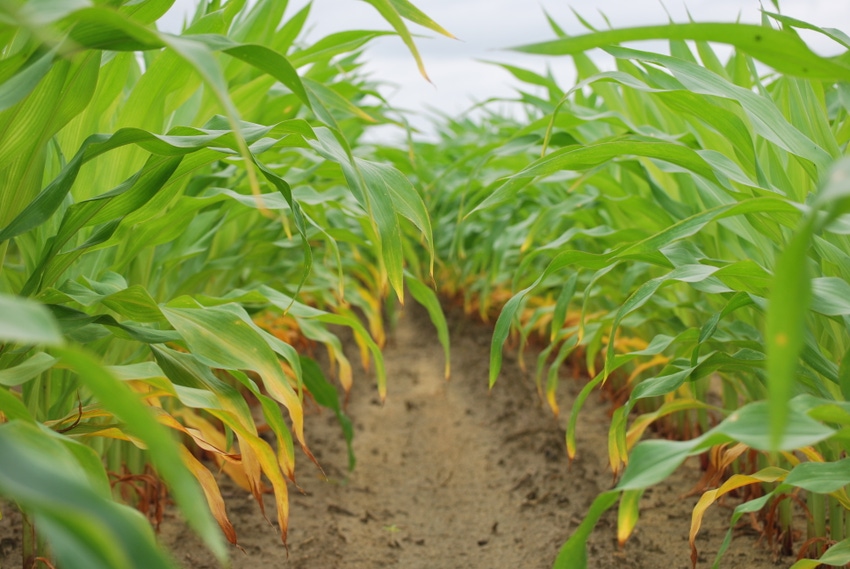
Many growers couldn’t buy a rain during the first half of May, and then couldn’t escape threats of daily downpours during the month’s second half. These periods of extreme weather have left some struggling to figure out the best next step in growing their crops in 2018.
As one farmer confided with frustration May 30, “Bob, I am behind in all of my sprays, and I still have to plant 435 acres of cotton and peanuts. How do I get out of this?”
The past two weeks of rain and the passage of Tropical Storm Alberto will very likely impact diseases and disease management options in at least four significant ways:
Moisture in the form of rain and high humidity creates a perfect environment for infection of our crops by fungal and bacterial pathogens. The ensuing diseases can spread more quickly during extended periods of rainy weather. Rain can splash fungal spores and bacteria from the soil and last year’s crop debris to the emerging seedlings and young plants and spread spores and bacteria from one infected leaf to other leaves.
The winds and rains of Tropical Storm Alberto followed a path from near the Yucatan Peninsula, through the Caribbean and to the fields of the southeastern United States. It is quite possible that spore-causing diseases like southern corn rust and soybean rust were swept up in the winds, carried in upper air currents and then deposited hundreds of miles away. The result for our growers will be increased risk to diseases like southern corn rust and soybean rust that must be introduced to most states annually.
Two weeks of dry weather followed by two weeks of rain has kept many farmers from finishing their planting for 2018. Delays in planting may increase risk to some diseases that could have been better avoided if planting had occurred earlier. Diseases that increase in severity because of delays in planting can include tomato spotted wilt and leaf spot diseases of peanut, and southern corn and soybean rust diseases. Diseases like target spot could be more severe if conditions are wetter and more humid on late-planted cotton.
Rains have delayed timely fungicide applications even as the peanut and corn crops approach growth stages important for protection. A significant portion of our corn crop has reached, or is approaching, the “tassel” growth stage (VT) and peanuts in some fields are at 30 days after planting, or beyond. Tassel and 30 days after planting are potential trigger-points in many growers’ fungicide programs.
The rainy weather has had on impact on two diseases and, according to reports on social media, seems to have affected a third. For peanut farmers, there is some good news. Aspergillus crown rot, a disease that can punish a peanut crop during hot and dry conditions, becomes much less important, and often unimportant, in wet, cooler soils. The rains have certainly slowed the development of Aspergillus crown rot.
Unfortunately, soreshin seedling disease of cotton, caused by the fungus Rhizoctonia solani, has been widespread across some fields this season. Unless growers take extra preventative measures to include use of additional seed treatments or in-furrow fungicides, there is nothing that can be done after closing the furrow.
On social media, a crop consultant from southern Georgia has reported bacterial blight on a young, susceptible cotton variety. Without further testing I would not be able to say exactly how the disease got into the field. However, recent periods of rain and 100% humidity have been perfect for infection to occur and for the disease to spread. I am not surprised to learn that the disease was found by an observant consultant on a susceptible variety. The final impact of the disease will be decided in large part by conditions throughout the rest of the season.
Extension agents and I are talking daily about critical management options for our growers now. Here are two of the most important considerations.
First, though southern corn rust has not been found, corn in many fields is risk for disease outbreak. I have not issued a general recommendation to treat corn with a fungicide because we have not found rust. Still, some growers will apply a fungicide anyway because of increased risk as a preventative spray can be very effective. I expect fungicides like Tebuconazole and Tilt to provide about two weeks of protection. I expect mixed products that include triazole, strobilurin, and/or SDHI fungicides to protect the crop for at least three weeks and perhaps longer. Choice of fungicide is important; timeliness and coverage are perhaps even more important.
Some peanut farmers are late in applying the first fungicide to their crop and are at increased risk to leaf spot. Growers who are behind in their fungicide program should get in the field as quickly as possible and consider using a systemic fungicide or mixing a systemic fungicide with their chlorothalonil for better control. Examples of systemic fungicides or fungicide mixes include Priaxor, Alto, Domark and Absolute among others. Timeliness is critical; systemic fungicides can help during periods of rainfall and delays in application.
Rain is not a bad thing. As another grower messaged this week, “I’d rather be a little late planting into moisture than putting seed in dry dirt with no irrigation. That is a recipe for bad seed stand and no residual chemical control.” Excellent point; however the rain has also brought its own challenges. I encourage growers to work with their local Extension offices to make best management decisions now and always.
About the Author(s)
You May Also Like






